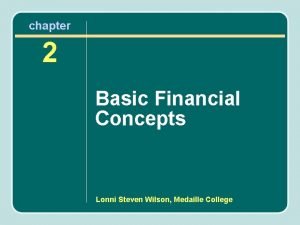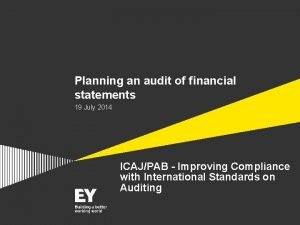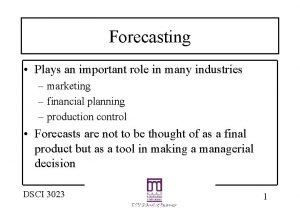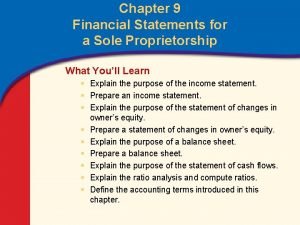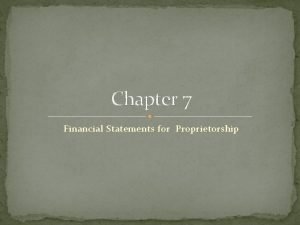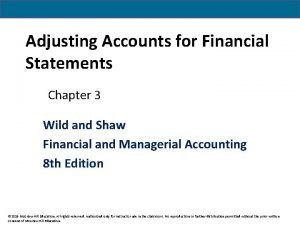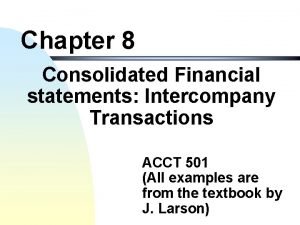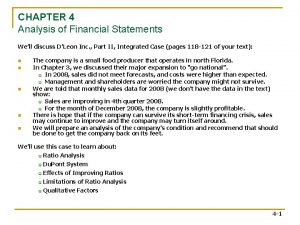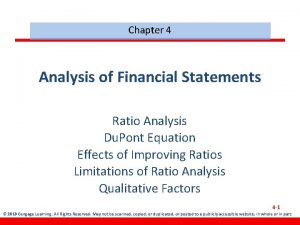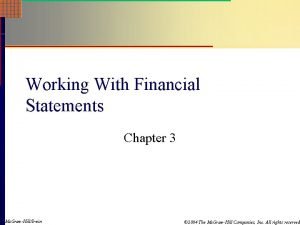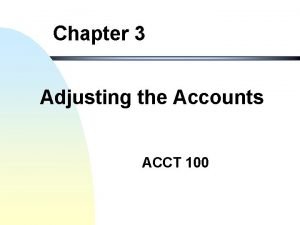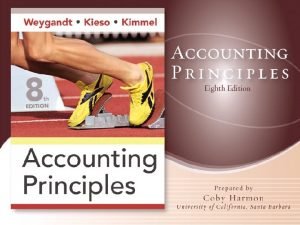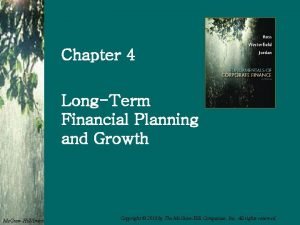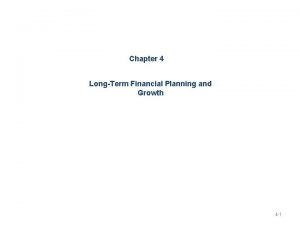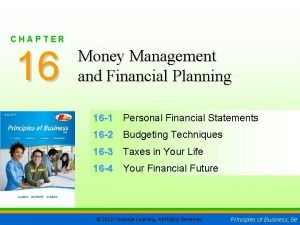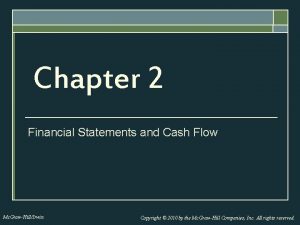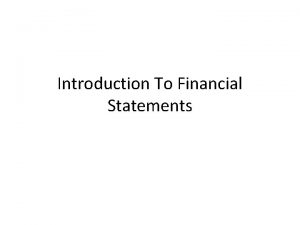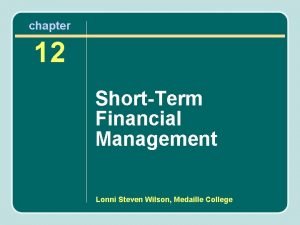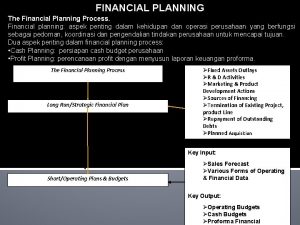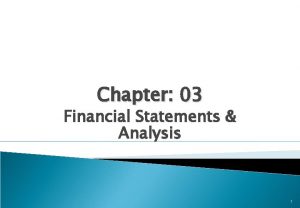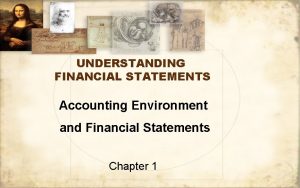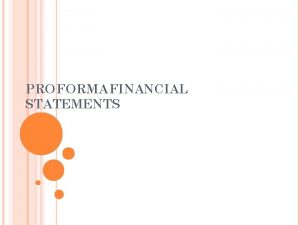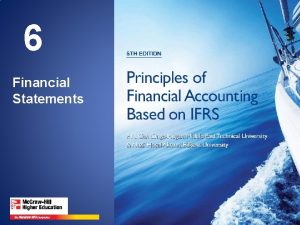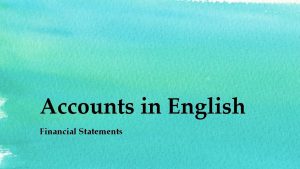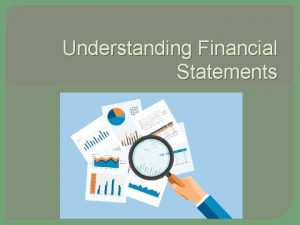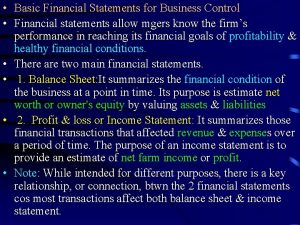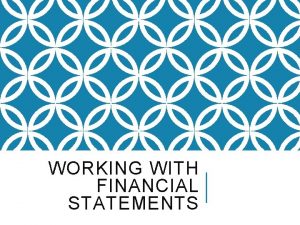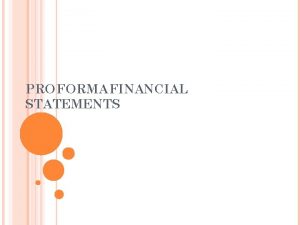chapter 5 Financial Statements Forecasts and Planning Lonni




























- Slides: 28

chapter 5 Financial Statements, Forecasts, and Planning Lonni Steven Wilson, Medaille College

Key Chapter Objectives • Identify the elements of the balance sheet and income statement. • Discuss the cash flow statement and relate it to the income statement and the balance sheet. • Define common financial ratios that can be used to assess an organization’s liquidity, activity, financial leverage, profitability, and inventory. • Understand the forecasting process.

Key Terms balance sheet—A document that displays the financial condition of a business at a single point in time. Basic definition: assets = liabilities + capital provided by owners. income statement—A document that describes how much profit or loss was earned by a business over a given length of time. statement of cash flows—A document that provides information about how the cash position of a business has changed over a given period of time.

Sample Balance Sheet Turn to Figure 5. 1 in the text on p. 70

Sample Income Statement Turn to Figure 5. 2 in the text on p. 71

Sample Statement of Cash Flow Turn to Figure 5. 3 in the text on p. 73

Key Terms assets—Any resource or goods that might offer future benefits to a business and have value. Assets are listed according to the length of time it takes to convert them to cash. liquidity—The ease and quickness with which assets can be converted to cash. liability—Any legal or financial obligation (e. g. , debt, retained earnings, shareholders’ equity, taxes owed). Listed on the balance sheet according to the length of time it takes to convert them to cash.

Current versus Fixed Assets Current assets (most liquid) • Assets that can be converted to cash in one year or less • Examples – cash – short-term financial assets – accounts receivable (money not yet collected from customers for goods sold to them) – inventory (raw materials used in manufacturing, in work in progress, or in finishing goods) – deferred income taxes and prepaid expenses (continued)

Current versus Fixed Assets (continued) Fixed assets (least liquid) • Assets on the balance sheet with the least liquidity • Examples – real estate – plant – equipment

Current versus Long-Term Liabilities Current liabilities • Must be paid in one year or less • Accounts payable (bills to vendors, not yet paid) • Compensation due to players, coaches, and management in one year or less • Interest and principal on long-term debt • Accrued liabilities (expenses recorded when they are incurred but before they are paid) (continued)

Current versus Long-Term Liabilities (continued) Long-term liabilities • Will not be paid down completely for more than one year • Players’ compensation (e. g. , five-year contract) • Shareholders’ equity (value of the stockholders’ investment in the company) • Deferred income taxes

Net Working Capital Also called simply working capital • Net working capital equals current assets minus current liabilities. • When this number is positive, the firm expects the cash paid out over the next year to be less than the cash that will become available. • An investment in working capital is an increase in net working capital between two points in time on a balance sheet.

Stars of David Balance Sheet Refer to figure 5. 1 in the text. • Identify the total amount of assets for the Stars of David. • Identify the total amount of liabilities for the Stars of David. • Identify the net working capital for the Stars of David. • Why is this number negative?

Income Statement Remember that the income statement describes how much profit or loss was earned by a business over a given length of time. • Income equals revenue minus expenses. • An income statement has three parts: 1. Revenues and expenses from the company’s operations 2. A nonoperating section that includes financing costs and any income earned by financial investments (also, all taxes) 3. Net income of the business

Key Terms revenue—Money coming into a business. expenses—Money going out of a business (payments; reduction in value, or depreciation; new legal obligations).

Stars of David Income Statement Refer to figure 5. 2 in the text. • Identify the total revenue amount for the Stars of David. • Identify the total expenses amount for the Stars of David. • What is the income for the Stars of David?

Key Terms depreciation—The cost of equipment and property that are used up by the organization in the process of producing and distributing goods and services. intangible assets—Nonphysical assets of the business that provide value (e. g. , goodwill, patents, licenses, trademarks, copyrights). cost of goods sold—Those expenses that are directly related to the production and distribution of goods and services (may be referred to as cost of sales). This includes raw materials, direct labor, and manufacturing overhead. Selling and general and administrative costs have separate lines.

Statement of Cash Flow Remember that the statement of cash flow provides information about how the cash position of a business has changed over a given period of time. • It measures cash flowing into and out of the business. • There are three primary sources: 1. Cash flows from (used in) operating activities 2. Cash flows from (used in) investing activities 3. Cash flows from (used in) financing activities

Stars of David Statement of Cash Flow Refer to figure 5. 3 in the text. • Identify the cash flows from (used in) operating activities for the Stars of David. • Identify the cash flows from (used in) investing activities for the Stars of David. • Identify the cash flows from (used in) financing activities for the Stars of David. • How and why are each of these numbers helpful?

Types of Financial Ratios • • • Liquidity Activity Financial leverage Profitability Value of the firm

Liquidity Ratios Measure the ability of a business to meet short-term financial obligations Current ratio • Measures if the sale of current assets will cover liabilities • Above 1 (can sell assets to cover liabilities) • Below 1 (cannot cover liabilities with sale) Acid test ratio • Also known as the quick ratio • Examines whether a firm can pay its current liabilities without relying on the sale of inventories

Activity Ratios Measure how effectively a firm manages its assets Total asset turnover ratio: How effectively the firm uses its assets to generate sales Inventory turnover ratio: How many times during the year the inventory is purchased and sold Receivables turnover ratio Average collection period

Financial Leverage Ratios Measure the extent to which a business relies on debts (loans) rather than equity (stocks) for financing. High ratios equal greater chance for distress and bankruptcy. Debt ratio analyzes a business’ leverage from the standpoint of assets. Debt–equity ratio analyzes a business’ leverage from the standpoint of owners’ equity. Interest coverage ratio

Profitability Ratios Measure the extent to which a business is profitable Return on assets (ROA) • Also known as return on investment • Reflects amount of profits earned on the investment in all assets of the firm • Measures profitability on investment by ALL providers of funds • ROA = net income / average total assets Return on equity (ROE) • Measures profitability on investment by stockholders • ROA = net income / average stockholders’ equity (continued)

Profitability Ratios (continued) Bottom line for companies is their ability to generate sufficient earnings to continue growth and reward shareholders Net profit margin: Net income divided by revenues Gross profit margin: Gross income divided by revenues Return on investment capital (ROIV): Analyzes performance via long-term investments that fund growth

Key Terms Market value of a firm—Based on what stock buyers and sellers establish when they buy and sell shares in the business (true “street value” of the business). Book value (also called owners’ equity)—Based on the historic cost of assets minus accumulated depreciation (does not necessarily represent true replacement value of an asset). Owners’ equity—Calculated by adding retained earnings and the value of common stocks (this calculation is also known as net worth). Book value per share—The amount of the firm’s value an individual stockholder has.

Techniques to Determine an Investment’s Value • Annual return per share: increase or decrease in value + dividends • Annual rate of return: annual return / initial investment • Dividend payout ratio: dividends per share / earnings per share • Earnings per share: net income / average number of shares outstanding • Price–earnings ratio (PE ratio): price per share / earnings per share

Questions for In-Class Discussion 1. Discuss the pros and cons of using the various measures of profitability to examine a company’s performance. 2. How would you finance the high growth of a business like Nike if you were not willing to borrow or raise additional capital? 3. Discuss the pros and cons of using the measures of leverage to assess whether a company faces financial distress. 4. What are some of the difficulties that one encounters when trying to project the future profitability of a team sports franchise?
 As compared to long-range forecasts, short-range forecasts
As compared to long-range forecasts, short-range forecasts Lonni wilson
Lonni wilson Compare and contrast analog and digital forecasts.
Compare and contrast analog and digital forecasts. Benefits of audit planning isa 300
Benefits of audit planning isa 300 Lesson outline lesson 3 answer key
Lesson outline lesson 3 answer key Forecasts play an important role in
Forecasts play an important role in Chapter 03 financial analysis
Chapter 03 financial analysis Financial statements and ratio analysis chapter 3
Financial statements and ratio analysis chapter 3 Flow chapter 2
Flow chapter 2 Adjusting accounts for financial statements chapter 3
Adjusting accounts for financial statements chapter 3 Chapter 9 financial statements for a sole proprietorship
Chapter 9 financial statements for a sole proprietorship Sole proprietorship financial statements
Sole proprietorship financial statements Adjusting accounts for financial statements chapter 3
Adjusting accounts for financial statements chapter 3 Chapter 8 separate financial statements
Chapter 8 separate financial statements Chapter 4 analysis of financial statements
Chapter 4 analysis of financial statements Chapter 4 analysis of financial statements
Chapter 4 analysis of financial statements Working with financial statements chapter 3
Working with financial statements chapter 3 Adjusting the accounts chapter 3
Adjusting the accounts chapter 3 The time period assumption states that
The time period assumption states that Chapter 4 financial decisions and planning
Chapter 4 financial decisions and planning Chapter 4 financial decisions and planning
Chapter 4 financial decisions and planning Long term financial planning and growth chapter 4
Long term financial planning and growth chapter 4 Internal growth rate formula
Internal growth rate formula Chapter 16 money management and financial planning
Chapter 16 money management and financial planning Chapter 16 money management and financial planning
Chapter 16 money management and financial planning Chapter 4 financial decisions and planning
Chapter 4 financial decisions and planning Chapter 4 financial decisions and planning
Chapter 4 financial decisions and planning Chapter 4 financial decisions and planning
Chapter 4 financial decisions and planning Cash flow to creditors is equal to
Cash flow to creditors is equal to

